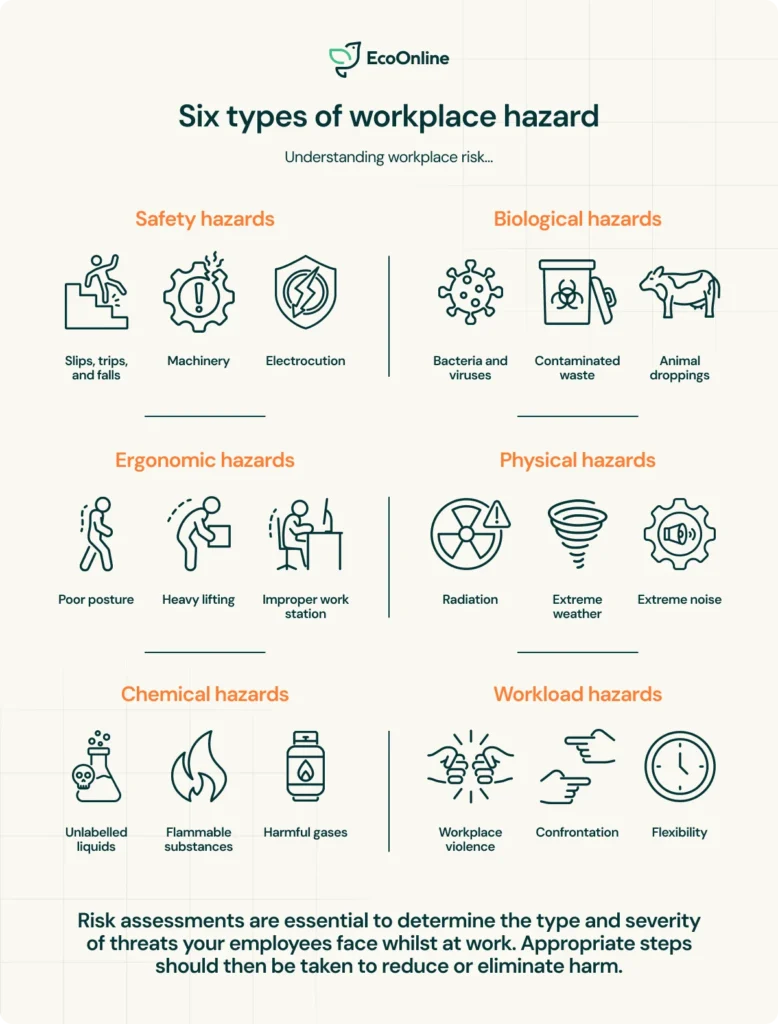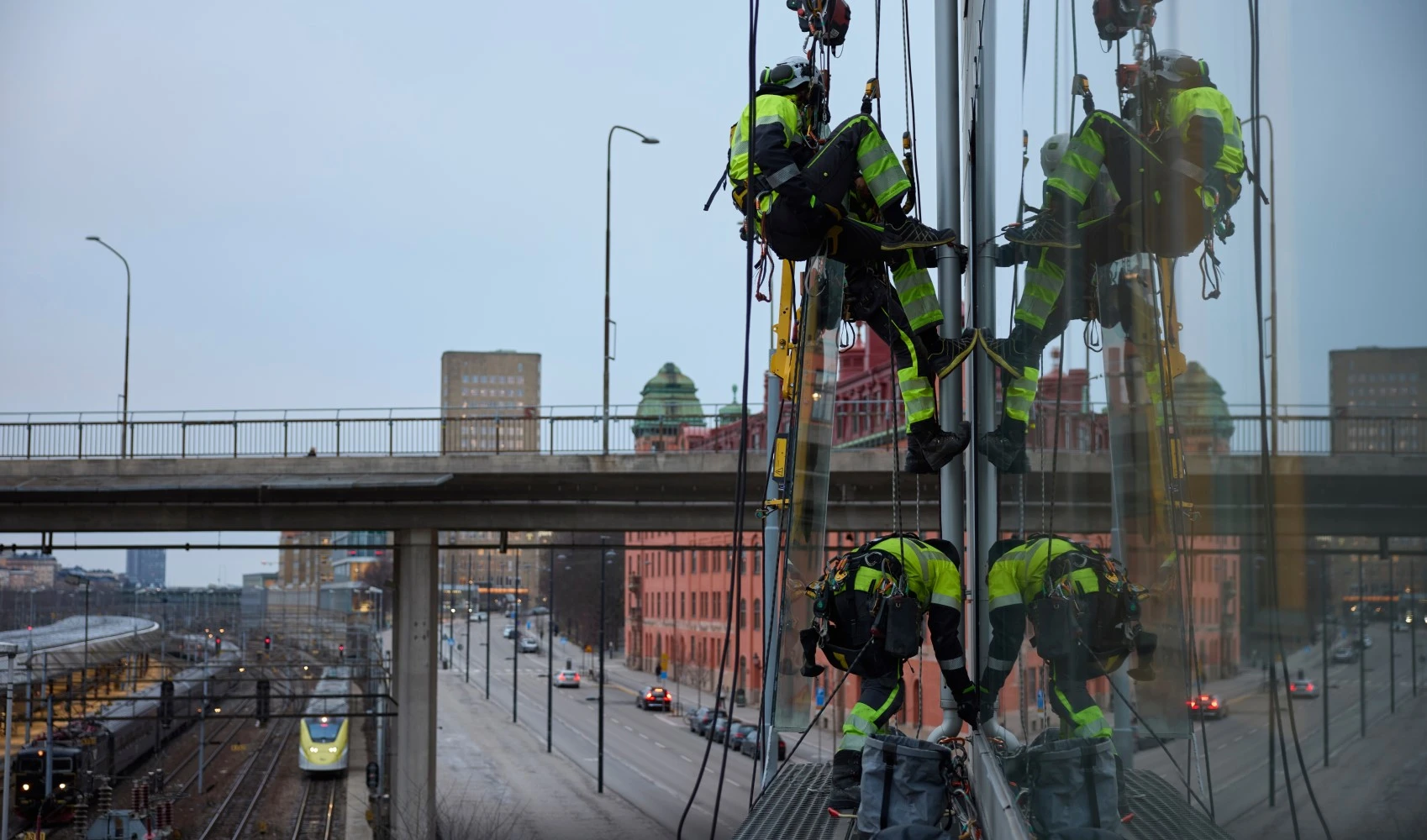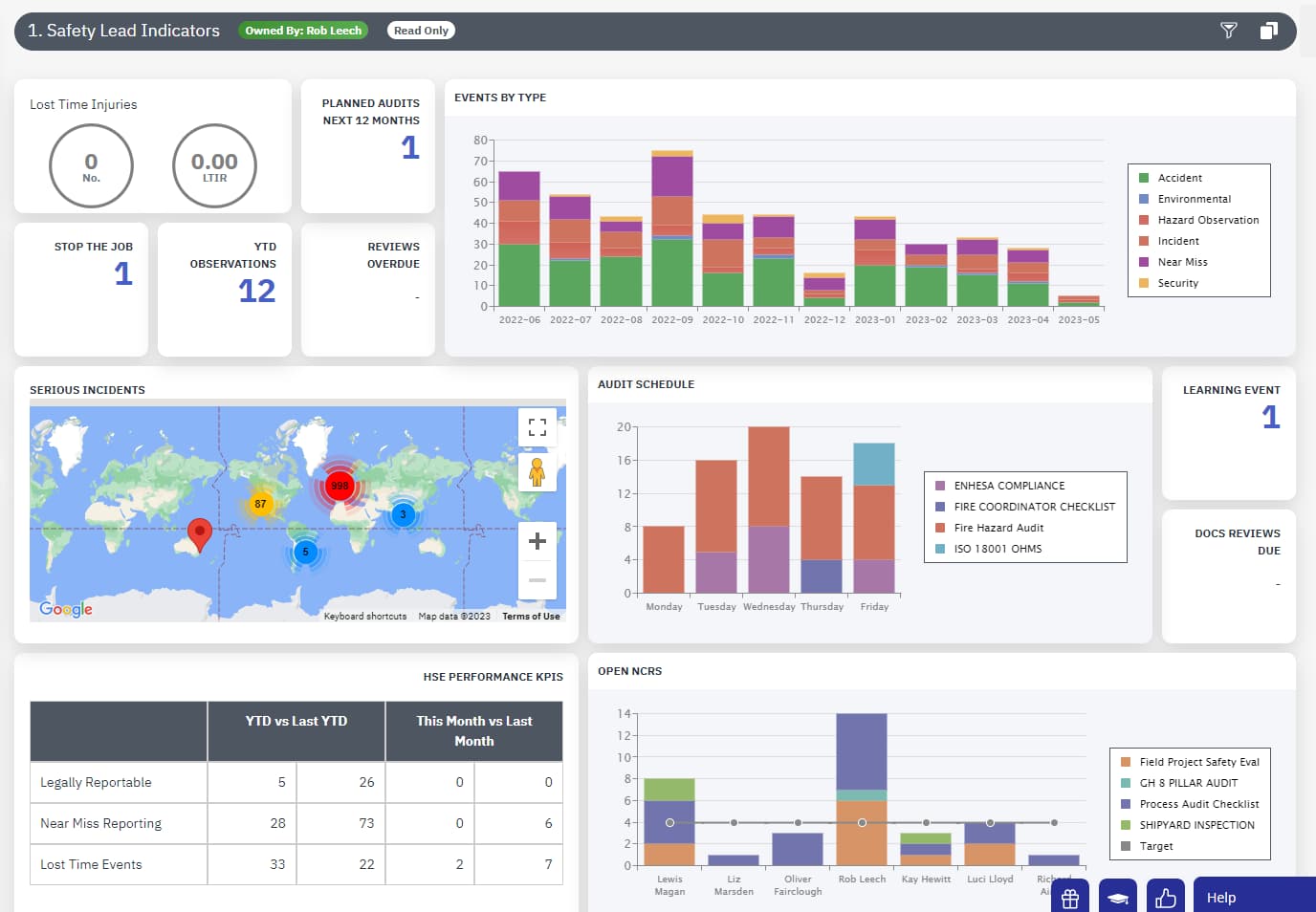6 types of workplace hazards

Workplace hazards are numerous and can arise daily. Every employer needs to identify and take steps to mitigate the risks that their workers may face.
Here we explore the 6 types of common workplace hazards, and what you can do to mitigate them.
What is a workplace hazard?
Hazards in the workplace occur when the working environment can cause injury, illness or death. The hazards can result from many of the different aspects of the working world, including equipment, dangerous materials, unsafe working practices and the behaviour of people.
For lone workers, hazards often present increased risk because they are less likely to have immediate support from colleagues.

Types of hazards
Workplace hazards fall into six core types – safety, biological, physical, ergonomic, chemical and workload.
1) Safety hazards
Safety hazards can affect any employee, but these are more likely to affect those who work with machinery or on a construction site. Safety hazards include slips, trips and falls, operatingdangerous machinery and electrical hazards.
2) Biological hazards
Biological hazards are extremely dangerous. These include exposure to dangerous substances and diseases associated with working amongst animals, people, or infectious plant materials. Employees who work in hospitals, laboratories or various other outdoor occupations are at risk from biological hazards.
3) Physical hazards
Physical hazards can affect those who work in extreme weather conditions or in harmful environments. Workers who are exposed to continuous loud noise, radiation, sun rays and ultraviolet rays could be at risk.
4) Ergonomic hazards
Ergonomic hazards affect individuals whose work puts a strain on their bodies. Manual roles that require lifting or sitting for long periods can cause damage over time. These hazards may not be noticeable at first which makes them much harder to identify. If your staff use improperly adjusted workstations or have poor posture when performing manual roles and heavy lifting, they may beat risk of injury.
5) Chemical hazards
Chemical hazards mainly threaten employees whose roles expose them to dangerous liquids, solvents or flammable gases. Individuals who are most likely to be affected are those working in cleaning facilities, engineers and employees in field-based roles. Exposure to harmful chemicals can cause illness, skin irritation, breathing problems and, in extreme cases, death.
6) Workload hazards
Workload hazards include issues that could cause stress or strain, such as workload, violence or aggression. These hazards can be experienced in any job role. However, lone workers may struggle to voice concerns due to their isolated work environment or find themselves a target for anti-social behaviour.

Tackling workplace hazards
It is important for employers and employees to understand the issues surrounding risks and hazards at work. Key topics to understand include:
Why is health and safety important in the workplace?
Health and safety in the workplace is important so that everyone who comes in contact with your business remains safe. The history of workplace safety has shown that if we don’t prioritise staff wellbeing, the consequences can be significant. Today we have strict legislation and penalties in place to ensure that businesses and employees adopt safe working practices. Thankfully, the introduction of legislation, along with an increased focus on health and safety training, procedures and policies has led to a reduction in workplace fatalities and injuries around the world.
Legislation and workplace health and safety
Businesses need to ensure that they understand current health and safety legislation to keep on the right side of the law. In the UK, businesses need to adhere to legislation including the Health and Safety at Work Act 1974 and Workplace Health and Safety Regulations 1992. Legislation differs across the world, for example, the US, Canada, Australia and New Zealand all have different laws.
It is also important that employee’s responsibilities for health and safety at work are understood, as both employers and staff have responsibilities when it comes to creating a safe working environment.
Who is responsible for workplace health and safety?
Both employers and employees have responsibilities when it comes to workplace health and safety welfare regulations. The law states that it is the duty of every employer to ensure, so far as is reasonably practicable, the health, safety and welfare at work of all employees.
Whilst the bulk of responsibilities lie with employers, employees must also ensure that they are working safely. This includes using equipment properly, adhering to any training they are given and reporting and/or removing any hazards they encounter.
Health and safety risk assessments
Health and safety risk assessments form a key part of risk management in the workplace, helping you to identify workplace hazards. The types of hazards, and how you mitigate them, can differ for lone workers. Lone workers should be considered separately when conducting risk assessments to ensure their specific safety needs are met, such as offering specialist training or issuing lone worker panic alarms.
Dynamic risk assessments
Dynamic risk assessments are risk assessments that are done ‘on the spot’ to help employees spot and reduce workplace hazards. They are specialist skills, which require employees to undertake specific health and safety training. For lone-working employees, several solutions have been developed that can help to minimise risk on the job,including apps that provide assistance in the event of an emergency.
Health and safety policies and procedures
Health and safety policies and procedures are important in ensuring everyone knows their responsibilities for keeping the workplace safe. A health and safety policy sets out your general approach to health and safety. It should include how an employer will manage health and safety in their business, including who should do what, when and how. Employers with more than five employees must write their health and safety policy down in a formal document.
How important is health and safety training
Training is key when it comes to identifying and handling hazards in the workplace. Effective training can be broad in scope but also needs to cover the right approach to the hazards encountered in specific work situations.
Essential parts of training cover:
- developing an awareness of hazards and risks
- the correct preparation, use and maintenance of equipment
- the right procedures for reporting faults and problems
- communicating with work colleagues, especially if working alone in hazardous situations
- dealing with other people in the workplace, including the public
Creating a positive safety culture in the workplace is also a key part of getting employees on board with health and safety. A positive health and safety culture means creating an environment where employees feel able to share any concerns they may have, without fear of getting into trouble. A positive safety culture is also beneficial to staff motivation and productivity.

How do lone worker apps improve health and safety?
Lone worker apps are becoming one of the most popular risk mitigation measures used by employers of lone-working staff.
EcoOnline’s StaySafe Lone Worker app offers employers a simple and effective way to monitor the safety of their remote working staff. Comprised of an app and online hub, StaySafe Lone Worker software provides employers with real-time updates on employees’ safety status and location while they work.
With GPS location, panic button and check-in features, the app also includes fall detection, which can alert monitoring services if an employee has not moved or checked in for a prolonged period. If an employee feels threatened or under attack, they can also raise an alarm discreetly by using the phone’s power button.
When an alert is raised by a lone worker, chosen monitors, either within the organisation or via a professional monitoring station, will be alerted. This will allow them to verify the alert and dispatch the appropriate assistance to the employee.













